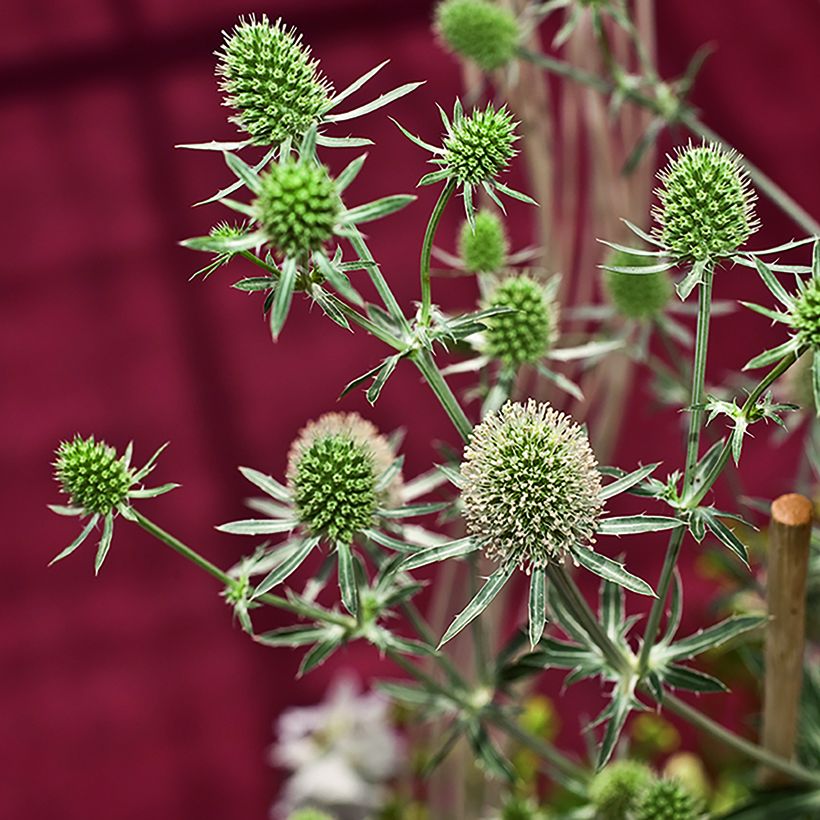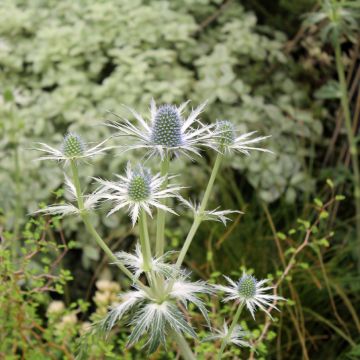

Eryngium planum White Glitter seeds - Flat Sea Holly


Eryngium planum White Glitter seeds - Flat Sea Holly
Eryngium planum White Glitter seeds - Flat Sea Holly
Eryngium planum White Glitter
Blue Eryngo, Flat Sea Holly, Blue Sea Holly
This item cannot be shipped to the selected country
Dispatch by letter from €3.90
More information
Schedule delivery date,
and select date in basket
This plant carries a 6 months recovery warranty
More information
We guarantee the quality of our plants for a full growing cycle, and will replace at our expense any plant that fails to recover under normal climatic and planting conditions.
Seed-only orders are dispatched by sealed envelope. The delivery charge for seed-only orders is €3.90.
Does this plant fit my garden?
Set up your Plantfit profile →
Description
Eryngium planum 'White Glitter' is a perennial blue thistle species also known as flat sea holly. This variety is a white-flowered form of the high-performing and award-winning 'Blue Glitter' variety. It produces superb ivory-silver flowers on silvery green branched floral stems. Its very bright colouring is even more appreciated in its preferred conditions: full sun, in poor, rocky, and fairly dry soil. This architectural, highly decorative plant is valued in slightly wild areas of the garden or in a rockery. Beautiful fresh or dried bouquets can be made with this charming plant. Sow in a pot from March-April or direct sow in place from May to July.
Eryngium planum or Eryngium armatum, known as flat sea holly, belongs to the Apiaceae family, just like celery and carrots. It is a perennial herbaceous plant with a root. Native to the mountains of central Europe, in the wild, it is found in dry and sunny locations, in very well-drained gravelly or sandy soil. With an upright and bushy habit, the 'White Glitter' thistle quickly reaches around 80 cm in height and 50 cm in spread. Its crown develops a rosette of ovoid, heart-shaped, thick, toothed, dark green, shiny leaves that remain evergreen in winter. Tall, dark, blue-grey, branched stems adorned with a few small thornless leaves rise from the basal rosettes. Flowering occurs in June-July at the end of these branches in the form of ovoid inflorescences of 2 cm in diameter, composed of numerous tiny azure blue flowers, surrounded at the base by thin toothed bracts of the same blue, with metallic highlights. This flowering attracts many pollinating insects. Eryngium planum readily self-seeds in light, well-drained soils.
The Wild Thistle does not live very long (especially in fertile, moist soil), but naturally self-seeds. In a countryside garden, its colour and design are appreciated alongside tall mulleins with yellow flowers, small annual love-in-a-mist nigellas with enchanting blue flowers, catmints, and shrubby salvias, as well as cosmos or roses. In a contemporary garden, it looks superb with grasses. The cut flowers are splendid in dried bouquets.
Report an error about the product description
Eryngium planum White Glitter seeds - Flat Sea Holly in pictures


Flowering
Foliage
Plant habit
Botanical data
Eryngium
planum
White Glitter
Apiaceae
Blue Eryngo, Flat Sea Holly, Blue Sea Holly
Cultivar or hybrid
Other Eryngium - Eryngo
Planting and care
Sow the seeds of Eryngium White Glitter from February to July, in trays, pots, etc. in a special seed compost placed in a propagator or a warm place to maintain an optimal temperature of 18-20°C. Cover the seeds with a thin film of vermiculite or compost. Do not exclude the light. Germination may be slow. Enclose the sowing in a plastic bag and maintain at 15-18°C for 2 weeks, then place it in the refrigerator (not the freezer) for 3 to 6 weeks. After this step, bring it back to the recommended germination temperature. If germination does not occur within 6 to 10 weeks, place it back in the refrigerator for another 3 to 6 weeks.
Regularly check any sowing stored in the refrigerator and immediately remove it if it shows signs of germination.
Prick out the young plants when they are large enough to handle into 8 cm diameter pots. Let them grow under a cold frame and plant them out in the garden the following spring. Maintain a spacing of 30 cm between each plant. Choose a sunny exposure and well-drained soil.
You can also try direct sowing in place from May to July in groups of 2 to 3 seeds. Germination in 20 to 30 days.
Sowing period
Intended location
This item has not been reviewed yet - be the first to leave a review about it.
Haven't found what you were looking for?
Hardiness is the lowest winter temperature a plant can endure without suffering serious damage or even dying. However, hardiness is affected by location (a sheltered area, such as a patio), protection (winter cover) and soil type (hardiness is improved by well-drained soil).

Photo Sharing Terms & Conditions
In order to encourage gardeners to interact and share their experiences, Promesse de fleurs offers various media enabling content to be uploaded onto its Site - in particular via the ‘Photo sharing’ module.
The User agrees to refrain from:
- Posting any content that is illegal, prejudicial, insulting, racist, inciteful to hatred, revisionist, contrary to public decency, that infringes on privacy or on the privacy rights of third parties, in particular the publicity rights of persons and goods, intellectual property rights, or the right to privacy.
- Submitting content on behalf of a third party;
- Impersonate the identity of a third party and/or publish any personal information about a third party;
In general, the User undertakes to refrain from any unethical behaviour.
All Content (in particular text, comments, files, images, photos, videos, creative works, etc.), which may be subject to property or intellectual property rights, image or other private rights, shall remain the property of the User, subject to the limited rights granted by the terms of the licence granted by Promesse de fleurs as stated below. Users are at liberty to publish or not to publish such Content on the Site, notably via the ‘Photo Sharing’ facility, and accept that this Content shall be made public and freely accessible, notably on the Internet.
Users further acknowledge, undertake to have ,and guarantee that they hold all necessary rights and permissions to publish such material on the Site, in particular with regard to the legislation in force pertaining to any privacy, property, intellectual property, image, or contractual rights, or rights of any other nature. By publishing such Content on the Site, Users acknowledge accepting full liability as publishers of the Content within the meaning of the law, and grant Promesse de fleurs, free of charge, an inclusive, worldwide licence for the said Content for the entire duration of its publication, including all reproduction, representation, up/downloading, displaying, performing, transmission, and storage rights.
Users also grant permission for their name to be linked to the Content and accept that this link may not always be made available.
By engaging in posting material, Users consent to their Content becoming automatically accessible on the Internet, in particular on other sites and/or blogs and/or web pages of the Promesse de fleurs site, including in particular social pages and the Promesse de fleurs catalogue.
Users may secure the removal of entrusted content free of charge by issuing a simple request via our contact form.
The flowering period indicated on our website applies to countries and regions located in USDA zone 8 (France, the United Kingdom, Ireland, the Netherlands, etc.)
It will vary according to where you live:
- In zones 9 to 10 (Italy, Spain, Greece, etc.), flowering will occur about 2 to 4 weeks earlier.
- In zones 6 to 7 (Germany, Poland, Slovenia, and lower mountainous regions), flowering will be delayed by 2 to 3 weeks.
- In zone 5 (Central Europe, Scandinavia), blooming will be delayed by 3 to 5 weeks.
In temperate climates, pruning of spring-flowering shrubs (forsythia, spireas, etc.) should be done just after flowering.
Pruning of summer-flowering shrubs (Indian Lilac, Perovskia, etc.) can be done in winter or spring.
In cold regions as well as with frost-sensitive plants, avoid pruning too early when severe frosts may still occur.
The planting period indicated on our website applies to countries and regions located in USDA zone 8 (France, United Kingdom, Ireland, Netherlands).
It will vary according to where you live:
- In Mediterranean zones (Marseille, Madrid, Milan, etc.), autumn and winter are the best planting periods.
- In continental zones (Strasbourg, Munich, Vienna, etc.), delay planting by 2 to 3 weeks in spring and bring it forward by 2 to 4 weeks in autumn.
- In mountainous regions (the Alps, Pyrenees, Carpathians, etc.), it is best to plant in late spring (May-June) or late summer (August-September).
The harvesting period indicated on our website applies to countries and regions in USDA zone 8 (France, England, Ireland, the Netherlands).
In colder areas (Scandinavia, Poland, Austria...) fruit and vegetable harvests are likely to be delayed by 3-4 weeks.
In warmer areas (Italy, Spain, Greece, etc.), harvesting will probably take place earlier, depending on weather conditions.
The sowing periods indicated on our website apply to countries and regions within USDA Zone 8 (France, UK, Ireland, Netherlands).
In colder areas (Scandinavia, Poland, Austria...), delay any outdoor sowing by 3-4 weeks, or sow under glass.
In warmer climes (Italy, Spain, Greece, etc.), bring outdoor sowing forward by a few weeks.














































